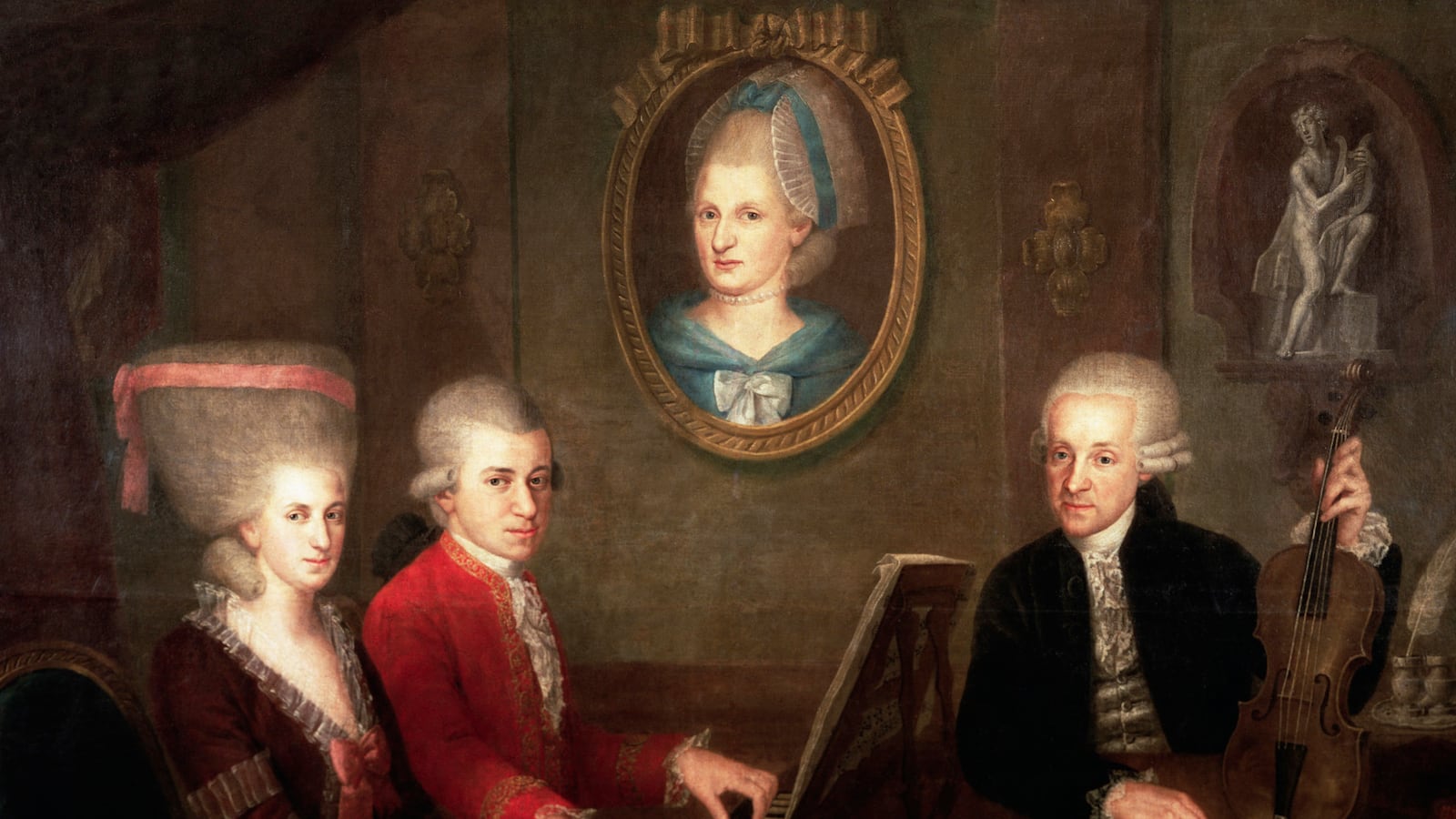Fourteen images of Wolfgang Amadeus Mozart made during his lifetime are known to exist, and the International Mozarteum Foundation in Salzburg, Austria, is showing 12 of them in an exhibit aimed at dispelling the myth of the composer as a romanticized figure—and to show what the man might have actually looked like.

This portrait, painted by his friend, the actor Joseph Lange, is perhaps the one likeness that best combines fame and authenticity. But the biggest criticism against it was that it was long thought to be unfinished. Researchers now say that this was not an incomplete work after all, but a finished portrait only of the composer’s head which was later grafted onto a larger canvas.
“Only a very few images of Mozart are universally agreed to be authentic. Yet the acceptance of these portraits—as well as more recently discovered portraits purporting to be Mozart—is less the result of provenance or connoisseurship than the fact that they are shrines at which Mozart scholars and Mozart lovers uncritically worship. They are representations of how we would like Mozart to look—in short they satisfy our visual biographical fancy. This is true, above all, of the unfinished portrait by Joseph Lange. The musicologist H.C. Robbins Landon described it as ‘the most intimate, most profound, of all the mature Mozart portraits—the only one, really, to catch the ambivalent nature of Mozart’s mercurial mind and to show the profoundly pessimistic side of his many-sided genius.’”—Cliff Eisen, “A New Portrait of Mozart?”

The young Mozart, by Pietro Antonio Lorenzoni. “For many people, Mozart has been and still remains the true musical representative of the Rococo, of the Anacreontic grace of the ancient regime—presumably because as a child he wore pig-tails and the jeweled dagger that was the emblem of gallantry. But this conception fits neither Mozart’s nature nor his external appearance, as may be seen merely by looking at the four portraits that are relatively the most faithful: the one in the Salzburg family picture, the Bologna portrait, Lange’s sketch in oils, and the penciled profile by Doris Stock. Mozart’s charm and grace are not Anacreontic, and they are not merely representative of the eighteenth century.”—Alfred Einstein, Mozart, His Character, His Work

A silverpoint drawing by Doris Stock, made in 1789. “Wolfgang Amadè Mozart, as he usually spelled his name, was a small man with a plain, pockmarked face, whose most striking feature was a pair of intense blue-gray eyes. When he was in a convivial mood, his gaze was said to be warm, even seductive.”—Alex Ross, “The Storm of Style,” in Listen to This

A miniature on ivory of the 17-year-old Mozart. “But he often gave the impression of being not entirely present, as if his mind were caught up in an invisible event. Portraits suggest a man aware of his separation from the world. In one, he wears a hard, distant look; in another, his face glows with sadness. In several pictures, his left eye droops a little, perhaps from fatigue. ‘As touchy as gunpowder,’ one friend called him. Nonetheless, he was generally well liked.” —Alex Ross, “The Storm of Style,” in Listen to This

A family portrait with Mozart in the center, his sister Maria Anna, a painting on the wall of their mother, Anna Maria, who died in 1778, and his father Leopold. It was made by Johann Nepomuk della Croce in 1780 or 1781. “If he did occasionally brag in his letters of his exceptional fluency in composition, simply to have written down all his works was a Herculean labor, without having also conceived them. Mozart occasionally boasted about his fluency in performance too, reporting to his father, for instance, that when he played for one Georg Friedrich Richter, Richter exclaimed, ‘Good God! How hard I work and sweat—and yet win no applause, and to you, my friend, it is all child’s play.’ To which Mozart replied, ‘Yes, I too had to work hard, so as not to have to work hard any longer.’”—Neal Zaslaw’s influential paper “Mozart as a Working Stiff”

A relief by Leonhard Posch, 1789. “Today, the most recent generation of music historians has attempted to dismantle the view of Mozart as a radical visionary and reduce him to an ordinary artisan, better at his job than anyone else, of course, but just trying to make a living.”—Charles Rosen, “Mozart at 250,” in Freedom and the Arts

Mozart 8Credit: Mozarteum Foundation
A silhouette by Heinrich Philipp Carl Bossler, 1784. “The basically lower middle-class composer lacked the talent to be an alcoholic, just as he lacked the talent to be a rake like Don Giovanni. Convivial by nature, he not doubt joined in when others were celebrating, allowing his boisterous high spirits free rein. Indeed, he may even have got carried away, as sometimes happened in his binges with Schikaneder. But he himself proved again and again that he needed no stimulants in order to compose, and the very appearance of his scores suggest quite the opposite of a composer destroyed by drink.”—Hermann Abert, W.A. Mozart, edited by Cliff Eisen and translated by Stewart Spencer

An engraving of Leopold on the violin, Mozart seated, and Maria Anna singing, by Jean-Baptiste Delafosse and based on a watercolor by Louis Carrogis de Carmontelle, 1764. “It was during his Dresden years that he gave a brief description of Mozart: ‘Mr. Mozart was an extremely eccentric and absent-minded young man, but not without a certain spirit of pride. He was very popular with the ladies, in spite of his small size; but he had a most unusual face, and he could cast a spell on any woman with his eyes.’”—the Italian baritone Luigi Bassi’s description, from The Cambridge Mozart Encyclopedia, edited by Cliff Eisen and Simon P. Keefe

An image attached to a snuffbox belonging to Mozart, by Joseph Maria Grassi, 1783. “The standard coupling of Mozart with another artist was to be Raphael, possibly initiated by the painter Ingres, who idolized both, and Mozart was transformed into an icon of classicism, an emblem of grace and purity. As the century proceeded, both Mozart and Raphael suffered, not from a loss of prestige—that was only too firmly in place—but from a growing disdain among the avant-garde of practicing artists and composers for the established classicism in favor with the academies of art and music. Bernard Shaw protested acutely that people did not realize how powerful Mozart was because his music was so beautiful. Brahms’s appreciation of Mozart was equally passionate and nostalgic: how wonderful it must have been to be a composer at the time of Mozart, he thought, “when it was easy to write music,” as if Mozart was the great representative of a prelapsarian age, before the exile from paradise.”—Charles Rosen, “Mozart at 250,” in Freedom and the Arts

A painting by Giuseppe Cignaroli, also known as Fra Felice. “Yet he was certainly fond of good company. At home, parties were limited to small musical gatherings that Constanze occasionally organized for a few friends, when he particularly enjoyed listening to Haydn’s music … But he was also a passionate dancer … Indeed, he sometimes even claimed that he had made more progress as a dancer than as a musician.”—Hermann Abert, W.A. Mozart, edited by Cliff Eisen and translated by Stewart Spencer

Mozart in Verona painted by Saverio Dalla Rosa in 1770. “He liked to be well dressed and was fond of lace, watch chains and so on, hence Clementi’s initial impression that he was one of the emperor’s chamberlains … As for food and drink, we may accept his father’s verdict without further ado, a verdict in any case confirmed by his sister-in-law Sophie Haibel, who insisted that he ate only the simplest fare.”—Hermann Abert, W.A. Mozart, edited by Cliff Eisen and translated by Stewart Spencer

A painting by Johann Georg Edlinger, sometimes considered to show the composer not long before his death in 1790, but hardly anyone believes is an authentic portrait of Mozart any longer. “All in all, the final decade of Mozart’s life was shrouded in a dark mist from which death alone was to release him. The brighter his artistry shone, the more somber his surroundings became.”—Hermann Abert, W.A. Mozart, edited by Cliff Eisen and translated by Stewart Spencer

Posthumous portrait of Mozart by Barbara Krafft, 1819. “To be sure, the mention of a red coat—possibly including even the buttons described by Mozart (although this is far from clear) - in two letters hardly proves that the sitter is Mozart. Not only were red coats not uncommon in Vienna at the time, but on at least three other occasions, both earlier and later, Mozart was himself depicted in a red coat, in the portrait by Saverio dalla Rosa executed at Verona in 1770, the family portrait of 1780-1 traditionally attributed to Johann Nepomuk della Croce, and in the posthumous Barbara Krafft portrait of 1819 (itself based on models sent to her by Nannerl). Nevertheless, there is no question that Mozart actually owned a red coat, as his estate documents show, and as independent testimony to a family recollection, the conjunction of letters and documents.”—Cliff Eisen, “Mozart in Italy and the Enigma of a Collection: Newly-Discovered Portraits and Artifacts”

An 18th-century portrait that researchers now say does not depict Mozart. “We cannot be sure if ‘composing freely’ is a concept that Mozart would have understood or desired: all the evidence is that he yearned to be needed and appreciated—to be asked to write music because people wanted it, to show off the skills of his singers and players as well as possible, to make the most of whatever practical performing circumstances he was faced with. Yes, he wanted his audiences to enjoy his music, and to show by their attention that they were enjoying it. Yes, he wanted his music to be better, cleverer, more passionate, and more memorable than everyone else’s, and probably believed it to be so, but there is not a shred of support for the idea that he ever consciously wrote for some far-distant future.”—Nicholas Kenyon, Faber Pocket Guide to Mozart






